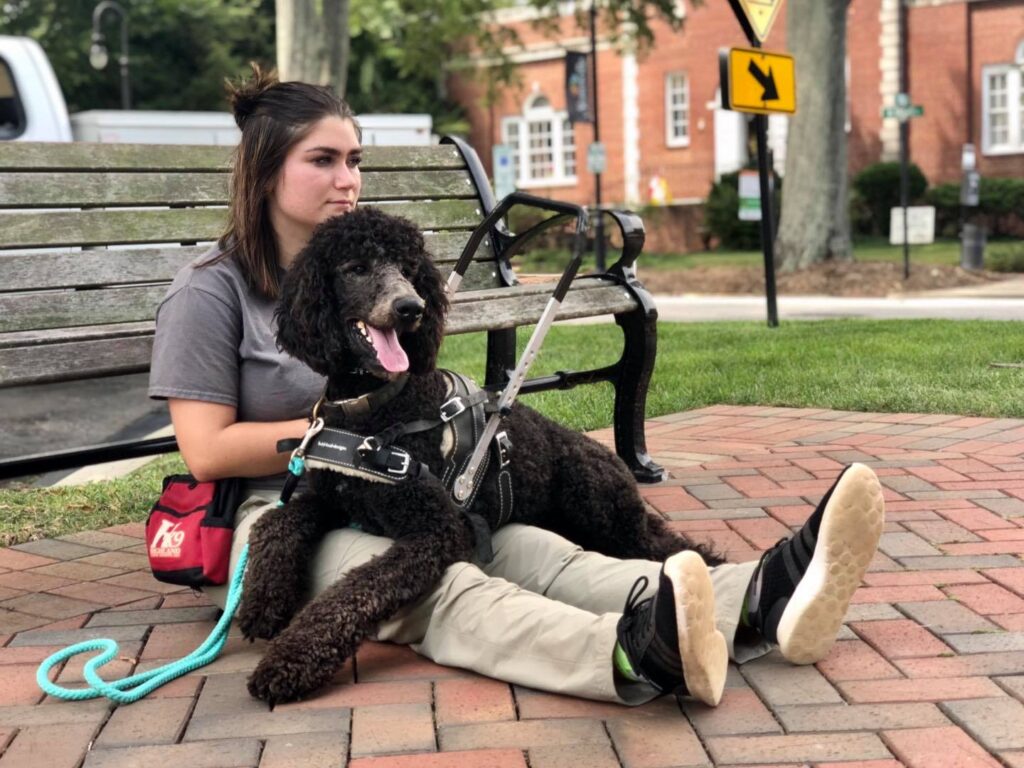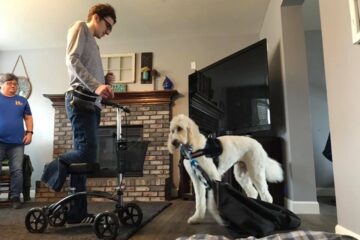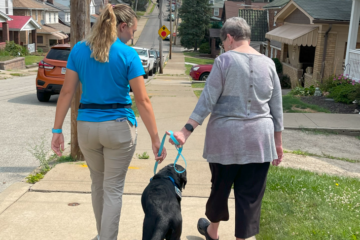Mobility Service Dogs are specifically trained to assist a handler that is either in a wheelchair, or needs help completing tasks that require movement.
Although each dog’s training is customized to the needs of their individual handler, there are four main tasks that every mobility service dog needs to be trained to perform. In addition to these four tasks, mobility service dogs will need to be extremely confident in new environments, have reliable obedience, and be well-socialized with other animals and new people.
Here are some of the tasks a mobility service dog will learn in training.
Heel with a wheelchair
Although all service dogs will learn a reliable heel while in their initial training phase, mobility service dogs have an even bigger challenge – learning how to heel alongside their handler’s equipment.
It is incredibly important to make sure the dog is exposed to the type of wheelchair their future handler will be using. Mechanical chairs and manual chairs differ and provide a shift in context for the dog, so heeling with a variety of different chairs throughout training is essential.
While heeling with a wheelchair, the dog is trained to keep their head and shoulders lined up with the front of the chair. At the same time, they must be walked on a loose leash and maintain the same pace as the chair. Not only does the dog need to learn to do this while moving in a straight line, they also need to learn how to maintain a proper position for turning and backing up. This requires extensive training and a solid understanding of hind end awareness in the dog.
The first step to heeling with a wheelchair is to socialize the service dog in training around wheelchairs from a very early age. This creates a positive association for the dog with wheelchairs. Next, the dog will learn to heel forward with the chair, thus learning the correct position. This involves a lot of short sessions and plenty of reinforcement.
Once the dog understands how to move forward, they learn how to turn right while holding position. This is easier than turning left, because the dogs are trained to heel on the left side in order to maintain the perfect position and make a 90 degree turn. Once the dog can make right turns consistently, they start on left turns.
Finally, once the dog is able to heel in a straight line moving forward and make left/right turns successfully, the dog needs to learn to back up while heeling. Backing up is vital because the dog needs to keep its hind end perfectly parallel to avoid getting in the way of the chair. This is typically accomplished by training the dog to back up away from the wheelchair to gain some hind end awareness. Most dogs are not comfortable walking backwards without practice and will swing their hind end to the right or left to begin turning around. Once the dog is comfortable with the motion, they need to learn to back up while heeling with a wheelchair. Utilizing a wall or fence in the early stages can help keep the dog parallel and in a heel. As the dog becomes more comfortable with the movement, distance can be created from the wall.

Fetch
While most dogs love to fetch toys as a game, mobility service dogs are trained to fetch and retrieve both dropped and specific items for their handlers. Utilizing this task prevents the service dog’s handler from needing to pick something up off the ground, but can also be trained to go and retrieve specific items such as a cell phone or set of keys.
A puppy being raised for this type of training is not scolded for picking up items with their mouth. If the dog learns from an early age not to grab items like shoes and keys they may not be inclined to pick up items as they get older.
The first step in teaching this task is teaching a dog to grab a variety of items. Some dogs may be more motivated starting off with toys. Once a dog understands they need to grab the toy by having the movement marked and rewarded, they then need to learn to put the item in their handler’s lap or hand. Once the dog understands where to put the retrieved item, the item can start to be generalized. It’s important that the dog has enough experience with a variety of sizes and textures, from pencils to paper clips, to rare clothing items that they never come across. In the final stage of training, different cues can start to be used for items that need to be retrieved frequently like a cell phone.
Opening doors

Mobility service dogs can be trained to open cabinets, the refrigerator and other doors for their handler around the home by pulling a tab or cord attached to the door handle.
For the first step, the dog needs to learn to pull on the tab away from the cabinet. This is usually done by engaging in a few short games of tug with the tab. Once the dog understands this, the tab can then be secured to a cabinet. Starting on doors that are easy to open (as opposed to a fridge or heavy door) is important. When the dog mouths at the tab, the trainer will mark and reward the dog. As the dog begins to understand this is how they will be rewarded, the trainer can start to build up each session, until the dog is opening the cabinet fully.
Once the dog understands the cabinet needs to be opened in order to be rewarded, the behavior can be generalized to cabinets that open in a different direction (so if the dog was opening a cabinet to the right, switch to the left). The next step will be moving to doors that require more effort to open, like the refrigerator.
Light switch

Dogs can also be trained to assist their handlers by turning light switches on and off. The dog will first need to learn to jump up and target the light switch with their nose. Once the dog can target the switch, the skill can be refined to target under the switch to flip it up. This skill will need to be generalized to a variety of environments. In their handler’s home, the service dog will learn where the switches are, and eventually be able to perform this task from quite a distance.
In conclusion
Mobility service dogs benefit their handlers by providing assistance with everyday tasks. Training for mobility tasks can take significant amounts of time in order for the behavior to be generalized and performed reliably in a number of environments.
The tasks that mobility service dogs are trained to do help provide their handlers with independence, and can be tailored depending on the needs of the handler.



0 Comments